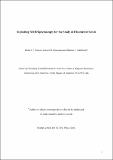Files in this item
Exploiting NMR spectroscopy for the study of disorder in solids
Item metadata
| dc.contributor.author | Moran, Robert F. | |
| dc.contributor.author | Dawson, Daniel M. | |
| dc.contributor.author | Ashbrook, Sharon E. | |
| dc.date.accessioned | 2018-08-12T23:33:25Z | |
| dc.date.available | 2018-08-12T23:33:25Z | |
| dc.date.issued | 2017 | |
| dc.identifier | 247294501 | |
| dc.identifier | 5ba7898b-f75b-4828-b2b0-0c3b149bba06 | |
| dc.identifier | 85014936303 | |
| dc.identifier | 000395783000002 | |
| dc.identifier.citation | Moran , R F , Dawson , D M & Ashbrook , S E 2017 , ' Exploiting NMR spectroscopy for the study of disorder in solids ' , International Reviews in Physical Chemistry , vol. 36 , no. 1 , pp. 39-115 . https://doi.org/10.1080/0144235X.2017.1256604 | en |
| dc.identifier.issn | 0144-235X | |
| dc.identifier.uri | https://hdl.handle.net/10023/15807 | |
| dc.description.abstract | Although the solid state is typically characterised by inherent periodicity, many interesting physical and chemical properties of solids arise from a variation in this, i.e.,changes in the nature of the atom occupying a particular site in a crystal structure or variation in the position of an atom (or group of atoms) in different parts of a structure, or variation as a function of time. This lack of long-range order poses significant challenges,not just for the characterisation of the structure of disordered materials, but also simply for its description. The sensitivity of nuclear magnetic resonance (NMR) spectroscopy to the local, atomic-scale environment, without the requirement for long-range order, makes it a powerful tool for the study of disorder in the solid state. Information on the number and type(s) of coordinating atoms or through-space and through-bond connectivity between atomic species enables the construction of a detailed picture of the structure. After a brief description of the background theory of NMR spectroscopy, and the experimental methods employed, we will describe the effects of disorder on NMR spectra and the use of calculations to help interpret experimental measurements. We will then review a range of applications to different types of disordered materials, including oxides and ceramics,minerals, porous materials, biomaterials, energy materials, pharmaceuticals, polymers and glasses. We will discuss the most successful approaches for studying different materials,and illustrate the type of information available and the structural insight gained. | |
| dc.format.extent | 10020837 | |
| dc.language.iso | eng | |
| dc.relation.ispartof | International Reviews in Physical Chemistry | en |
| dc.subject | Solid-state | en |
| dc.subject | NRM spectroscopy | en |
| dc.subject | Disordered materials | en |
| dc.subject | DFT calculations | en |
| dc.subject | Inorganic solids | en |
| dc.subject | QD Chemistry | en |
| dc.subject | TP Chemical technology | en |
| dc.subject.lcc | QD | en |
| dc.subject.lcc | TP | en |
| dc.title | Exploiting NMR spectroscopy for the study of disorder in solids | en |
| dc.type | Journal item | en |
| dc.contributor.sponsor | European Research Council | en |
| dc.contributor.sponsor | The Royal Society | en |
| dc.contributor.institution | University of St Andrews. School of Chemistry | en |
| dc.contributor.institution | University of St Andrews. EaSTCHEM | en |
| dc.identifier.doi | 10.1080/0144235X.2017.1256604 | |
| dc.description.status | Peer reviewed | en |
| dc.date.embargoedUntil | 2018-08-13 | |
| dc.identifier.grantnumber | 614290 - EXONMR | en |
| dc.identifier.grantnumber | WM150021 | en |
This item appears in the following Collection(s)
Items in the St Andrews Research Repository are protected by copyright, with all rights reserved, unless otherwise indicated.

